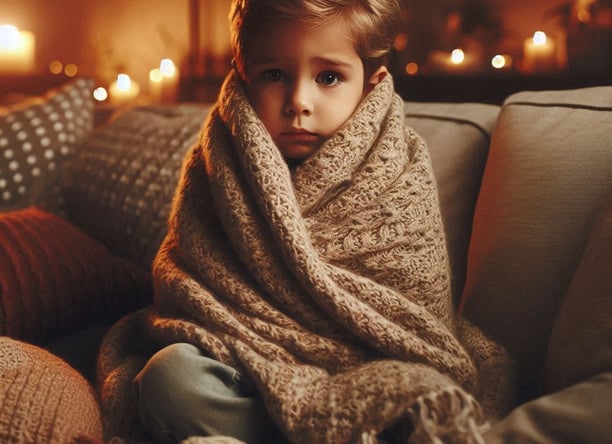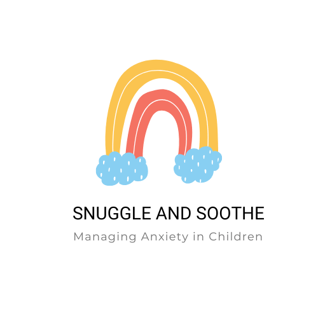Creating a Safe Space for Children with Anxiety: Strategies for Comfort and Support
5/21/20255 min read


Understanding Anxiety in Children
Anxiety in children is a prevalent mental health issue, impacting their emotional and psychological well-being. Many children experience anxiety, which can manifest in various forms and symptoms depending on their age and developmental stage. In younger children, anxiety may present as clinginess, tantrums, or physical complaints like stomach aches or headaches. As children grow, especially during school-age years, they may exhibit anxiety through avoidance behaviours or excessive worry about performance and peer relationships. Adolescents often display anxiety by withdrawing socially, experiencing panic attacks, or having difficulty concentrating.
Recognizing the signs of anxiety is crucial for parents and caregivers. Early identification allows for timely intervention, which may alleviate symptoms and improve quality of life. Common indicators of anxiety in children include persistent feelings of dread, restlessness, hypervigilance, or irritability. Some children may also struggle with sleep disturbances or changes in appetite, which are often interconnected with their emotional state. It is vital for caregivers to notice these signs and consider the context in which these behaviours occur, as they can significantly influence a child's ability to thrive in their environment.
Creating a supportive environment is essential for helping children manage anxiety effectively. A nurturing atmosphere where children feel safe to express their feelings encourages open communication about their experiences. Parents and caregivers play a critical role in fostering this safe space by validating their child's emotions and encouraging them to talk about their concerns. When children know that their feelings are understood and accepted, they are more likely to develop coping strategies. Thus, providing comfort and support can foster resilience and slowly reduce anxiety symptoms, improving overall mental health in the long term.
The Importance of Calming Elements
Creating a safe space for children with anxiety involves more than just offering emotional support; it also entails shaping their physical environment to promote tranquility and comfort. One of the most significant factors in establishing this kind of environment is the integration of calming elements, such as soft, adjustable lighting and soothing colours. The right lighting can significantly reduce overstimulation, making it easier for children to relax and feel secure.
Soft, diffused lighting, as opposed to harsh fluorescent bulbs, can help in diminishing anxiety triggers. By utilizing adjustable lighting options, caregivers can tailor the intensity to suit the child’s needs at any given moment. For instance, dimmable LED lights can create a gentle ambiance that allows children to unwind, preventing feelings of overwhelm that are often exacerbated by bright or flickering lights. This strategic use of calm lighting serves to foster relaxation and encourages the child to develop a sense of control over their environment.
The choice of colours in a child's safe space also plays a crucial role. Soft hues such as pastel blues, greens, and lavenders have been shown to possess calming properties. These colours do not compete for attention and can induce a sense of peace, conducive to emotional regulation. Incorporating these shades on walls or through decorative elements can transform a room into a sanctuary, one that children can retreat to when feeling anxious.
In addition to lighting and colour, including cosy spaces, such as reading nooks or softly furnished corners, can provide children with a personal retreat. These designated areas allow children to step away from overwhelming situations, giving them room to breathe and recentre themselves. Such features are essential in the ongoing efforts to mitigate anxiety, as they support the child's ability to manage anxious feelings effectively, promoting well-being and resilience in the process.
Using Weighted Blankets and Sensory Toys
Weighted blankets and sensory toys are increasingly recognized for their therapeutic benefits in alleviating anxiety in children. A weighted blanket provides deep pressure stimulation, which can create a calming effect akin to a gentle hug. This sensation helps release serotonin, a chemical that contributes to feelings of well-being, while also reducing cortisol levels, which are associated with stress. For children suffering from anxiety, using a weighted blanket can create a sense of security and comfort, making it easier for them to manage their feelings in stressful situations.
When selecting a weighted blanket, it is crucial to ensure that it is appropriate for the child’s size and weight. A common guideline is to choose a blanket that is roughly 10% of the child's body weight plus a pound. This ensures the blanket provides the right amount of pressure without being overwhelming. Additionally, consider the material of the blanket; breathable fabrics can help regulate body temperature and prevent discomfort during use.
In complement to weighted blankets, sensory toys also play an important role in providing comfort and distraction for children with anxiety. These toys are designed to engage multiple senses and can vary widely from fidget spinners to textured balls and calming putty. Sensory toys allow children to focus their attention away from anxiety-inducing thoughts and engage in calming activities that promote relaxation. Selecting the right sensory toys should take into account the child's individual preferences, as each child may respond differently to various textures, weights, and functionalities.
Incorporating weighted blankets and sensory toys into a child's daily routine can be incredibly beneficial. These tools not only help in managing anxiety but also create an environment conducive to relaxation and emotional stability. Ultimately, finding the right combination of these resources can empower children to cope with their feelings more effectively.
Incorporating Soothing Sounds and Music
The role of sound in establishing a nurturing and supportive atmosphere for children experiencing anxiety cannot be overstated. Research has shown that calm music, nature sounds, and white noise can significantly diminish anxiety levels and foster a sense of tranquility. By carefully selecting and incorporating these soothing sounds, caregivers can create an environment that enhances emotional well-being and promotes relaxation.
One effective approach is curating a personalized soundscape tailored to the individual preferences of the child. Some children may find solace in soft instrumental music, while others might prefer the gentle rustling of leaves or the rhythmic sound of ocean waves. It is essential to engage the child in this process, allowing them to choose sounds that resonate with them. This participation can empower children, helping them to feel more in control of their environment and emotional state.
In addition to personal preferences, the timing and setting for using these soothing sounds are crucial. For instance, calming music can be particularly beneficial during bedtime rituals, helping to create a peaceful transition into sleep. Similarly, nature sounds can be played during moments of high stress or anxiety throughout the day. White noise machines can also be invaluable during periods when distractions may hinder relaxation, such as during homework or quiet time.
To maximize the soothing effects, caregivers should consider adjusting the volume to a gentle level, ensuring that the sounds are not overpowering. Subtlety is key, as overly loud sounds may have the opposite effect, leading to increased stress rather than relief. Furthermore, incorporating these calming sounds into a daily routine can establish predictability, further enhancing a child's comfort and reducing anxiety levels over time.
Snuggle and soothe participates in the Amazon Services Associates Programme, as well as other affiliate programmes. If you make a purchase through these, I earn from the qualifying links. This is at no extra cost to you.
